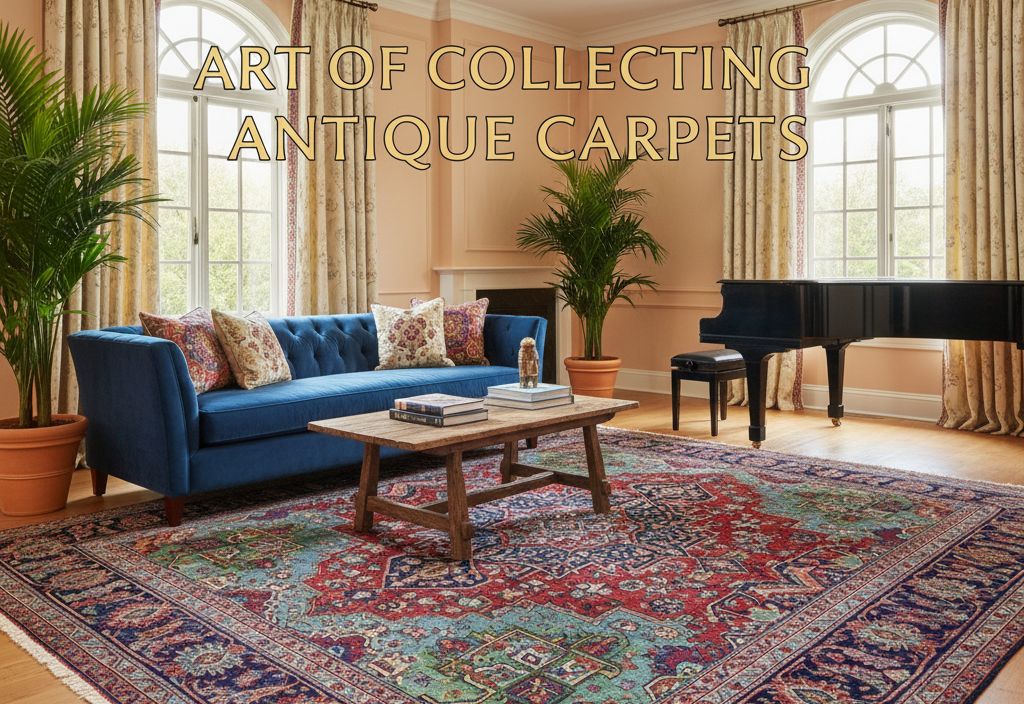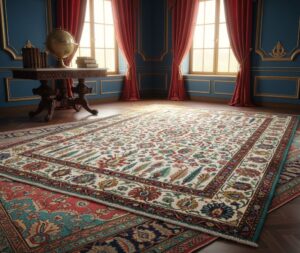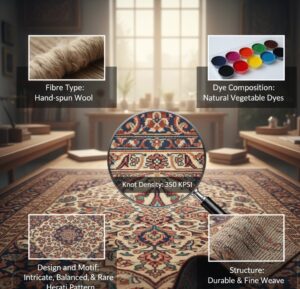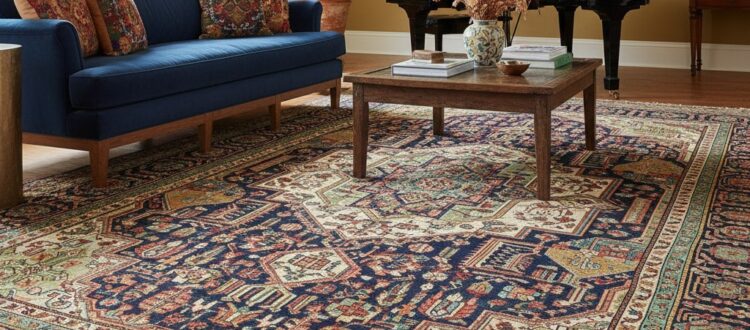Woven Wonders: The Art of Collecting Antique Carpets and Rugs
Picture walking into a room where the floor itself tells a story. Not with words — but with colour, pattern, and history. A handwoven antique Persian carpet or a tribal rug spun with natural dyes, carrying symbols of protection and luck, all these are cultural treasures that carry a tale in their thread.
Far more than mere floor coverings, these textiles are living pieces of folk art, portable repositories of cultural heritage, and vibrant testaments to human craftsmanship.
Today, these textiles have evolved beyond mere décor—they are coveted collectible investments, cherished both in private homes and prestigious auctions such as Giftex’s world of collectibles.
Collecting antique carpets and rugs isn’t just about owning something beautiful. It’s about preserving history underfoot — a living art form that connects past and present, tradition and design.
Welcome to the world of antique rug collecting — where craftsmanship meets culture, and passion meets legacy.

Also Read: The Journey of Carpets Through Time
The Allure of Antique Carpets and Rugs
Antique rugs have captivated collectors, designers, and historians for centuries. Their appeal lies in their perfect balance of artistry, utility, and symbolism.
Each carpet is a cultural fingerprint — woven by artisans whose techniques and motifs reflected their geography, faith, and way of life. From Persian floral medallions to Turkish geometric patterns and Caucasian tribal motifs, every design tells a story of its origin.
Beyond beauty, these rugs embody endurance. The best antique carpets have survived generations, their dyes deepening, their wool softening, their value growing.
Why Collect Antique Carpets?
The motivations for collecting antique rugs are as varied as their origins.
- Aesthetic Value: Antique rugs bring warmth, texture, and depth to interiors, transforming spaces into living art galleries.
- Cultural Significance: Each rug is a cultural narrative—reflecting the customs, tribal origins, and creativity of its weavers.
- Investment Potential: Rare, well-preserved pieces appreciate in value, making them a rewarding collectible asset.
- Sustainability: Antique carpets represent a form of eco-conscious collecting—honouring existing craftsmanship rather than new production.
The Art of Collecting: Where Passion Meets Precision
The art of carpet collecting combines passion with careful evaluation. To truly appreciate and preserve these textile treasures, collectors must train their eyes and mind to discern authenticity, quality, and value.
A. Understanding Origin and Provenance
Antique carpet and rug appraisal starts with understanding where a piece comes from and how it was made.
- Age: The Weight of Time

The first step in evaluating an antique rug is determining its age. A true antique is typically 100 years or older, while pieces aged 50–100 years fall into the “vintage” category.
Clues like natural fading, patina, and wear patterns help experts estimate when and where a rug was woven. Older rugs often reveal subtle irregularities in weave and design — small imperfections that only hand craftsmanship can create.
- Origin: Where the Story Begins
The rug’s place of origin reveals its artistic identity and weaving tradition. Each region — from Persia to Turkey, India, or the Caucasus — has a distinct design language, dye palette, and knotting method.
Persian rugs are celebrated for floral medallions, silk threads, and exquisite detailing.
Turkish rugs showcase geometric patterns and the durable double-knot technique.
Caucasian tribal rugs feature vivid colours and symbolic motifs.
Indian carpets often carry Mughal artistry — intricate, elegant, and richly dyed.
- Provenance: The Story of Ownership

Provenance traces the history of ownership — where the rug has travelled and who has cherished it.
A rug that once belonged to a noble family, an old estate, or a museum collection holds added prestige. Provenance not only authenticates but also enriches a rug’s narrative and value.
Proper documentation — auction records, certificates, or estate inventories — turns a textile into a traceable piece of history.
- Craftsmanship: The Human Touch
What separates an antique rug from a reproduction is the hand of the weaver.
Each knot is tied with intention, each colour chosen with meaning. True antique rugs are hand-knotted, not machine-made, and their artistry is visible in every detail — from balanced symmetry to natural dye tones that have mellowed gracefully over decades.
Knot density (measured in knots per square inch, or KPSI) is a key indicator of craftsmanship: the higher the count, the finer the rug.
B. The Appraisal Process: How to Evaluate Antique Carpet Value
Appraising an antique rug is both art and science. Experts combine research, tactile inspection, and comparative analysis to determine true market value.
Here’s how the process unfolds:
- Deep Research
Every appraisal begins with research — understanding the rug’s weaving tradition, region, and cultural background.
Specialists compare the piece against historical weaving references, museum collections, and academic archives. Research lays the groundwork for authenticity.
- Detailed Analysis

Next, the rug’s materials, structure, and artistry are examined in detail:
Fibre Type: Wool, silk, or cotton — each affects durability and value.
Dye Composition: Natural dyes age beautifully; synthetic dyes may reduce value.
Knot Density: Measured in KPSI; finer weaves often indicate superior craftsmanship.
Design and Motif: Intricacy, balance, and rarity of patterns are key.
- Comparative Research
Once the rug’s characteristics are documented, appraisers conduct comparative market research.
They study recent auction results, dealer records, and museum acquisitions for rugs of similar age, type, and quality. This benchmark helps establish a fair market range.
No two antique carpets are identical — but patterns of demand and rarity reveal where a rug fits in today’s collector landscape.
- Condition Assessment
Condition can dramatically elevate or diminish a rug’s value.
Appraisers look for:
- Even pile and preserved structure
- Minimal moth damage or dry rot
- Intact edges and fringes
- Gentle wear consistent with age
- Professional restoration (if done with care and documented)
- Documentation and Certification
The final stage of appraisal involves documenting and certifying all findings.
- An official appraisal report includes:
- High-resolution photographs
- Descriptions of design, material, and technique
- Historical background and provenance
- Condition notes
- Estimated value (insurance and market)
This documentation serves as both proof of authenticity and a record for future buyers, insurers, or heirs.
Trusted auction houses — such as Giftex Online Auction House — often provide certified appraisals backed by textile experts, ensuring transparency and confidence for collectors.
How Antique Carpets Elevate Home Décor

Antique carpets do more than adorn a room — they anchor it.
A handwoven rug can completely transform a space by adding warmth, texture, and history. Whether under a coffee table, in a hallway, or hung like a tapestry, antique carpets command attention without overpowering.
For modern interiors: A faded Persian rug adds contrast and depth to minimalist designs.
For traditional settings: An Oriental or Kashmiri carpet enhances grandeur and richness.
For eclectic spaces: Mixing tribal rugs with contemporary art creates visual dialogue.
Their imperfections — slight asymmetries, uneven dyes — are what make them perfect. Each one adds soul where mass-produced décor cannot.
Owning one turns a house into a home — and a floor into a story.
Giftex: A World of Collectibles Auction
If you’re ready to begin or grow your collection, there’s one name you should know: Giftex Online Auction House — your gateway to authentic, handpicked antique carpets and rugs from across the world.
Giftex curates a stunning range of collectible textiles, each verified for authenticity, craftsmanship, and provenance. From Persian silk masterpieces to tribal wool rugs, every auction offers the chance to own a rare piece of art that has stood the test of time.
So, if you’re passionate about the art of collecting, don’t miss the next auction.
Stay tuned, stay curious, and step into the world where every thread tells a story.
A Legacy Woven in Time
Collecting antique carpets and rugs isn’t just about aesthetics — it’s about connection. Each knot, colour, and weave embodies a weaver’s heartbeat and a culture’s soul.
From Persian palaces to nomadic tribal rugs, these textiles have crossed centuries and continents to land in our living rooms — carrying beauty, history, and identity.
So, whether you’re an aspiring collector or a design enthusiast, let your next treasure last underfoot — a masterpiece that keeps history alive.
Because when you collect antique carpets, you’re not just collecting décor.
You’re collecting heritage, artistry, and time itself.






